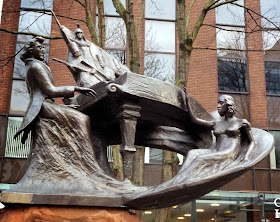The architect Basil Champneys designed the magnificent neo-Gothic John Rylands Library, which was opened to readers in 1900 after taking ten years to construct. It is a memorial by Enriqueta Rylands (1843–1908) to her husband John Rylands (1801–1888), and is now part of the University of Manchester.
In the Reading Room is the statue of John Rylands at one end.
And Enriqueta at the other.
Both north and south windows are by Charles E. Kempe. Above is the south Arts Window. In the upper panels, from left to right, are representations of: Socrates, Epicletus, Marcus Aurelius, Plato, Aristotle, Lucretius, Cicero, Aeschylus, Raphael and Beethoven; in the lower panels: Samuel Johnson, Wordsworth, Carlyle, Descartes, Locke, Kant, Hegel, Dante, Michelangelo and Handel.
North is the Theology window. In the upper panels, from left to right, are representations of: St Anselm, St Thomas Aquinas, Duns Scotus, Moses, Isaiah, St John, St Paul, Richard Hooker, Thomas Cartwright and Hugo; in the lower panels: Erasmus, Beza, Melanchthon, Origen, St John, Chrysostom, St Jerome, St Augustine, Bishop Butler, Jonathan Edwards and Schleiermacher.
At the time of our visit a few weeks ago an exhibition called 'Bona Eek! The Polari Mission' by Jez Dolan and Joseph Richardson was coming to its end. Above is Dolan's 'A Polari Etymology', loosely based on Alfred H. Barr's 1936 programme cover for the MOMA 'Cubism and Abstract Art' exhibition.
This is Dolan's The Lion of Chaeronea. Founded by George Cecil Ives (1867 –1950), a poet and gay rights campaigner, the Order of Chaeronea was a secret society of homosexuals named after the place where the Sacred Band of Thebes (150 pairs of male lovers) were killed in 338 BC. Quite possibly, Oscar Wilde and Bosie were members.



























































